Stay and Play in Egypt. |
HOTELS AND SIGHTSEEING
LUXOR
I am of the firm belief that you cannot come to Egypt without visiting Luxor. Once the site of Egypt's capital, it is the concentration of tombs and temples that make this city so culturally rich. It isn't difficult to see why the Temple of Karnak, dedicated to the great god Amun, is one of the greatest ancient sites in Egypt. Cross over to the west bank and lose yourself in the splendor of the tombs of paraohs, queens and noblemen. It is worth taking a guided tour of Luxor for the wealth of knowledge that a guide can provide and for the transportation between distant sites.
Hotel:
- ***Arabesque Hotel: Mohammed Farid St., Tel: 372-193
- ***Emilio Hotel: Youssef Hassan St., Tel: 373-570
- ****Hotel Mercure Luxor Hotel: Corniche El Nil. Tel: 380-944
- *****Luxor Hilton Resort & Casino: New Karnak. Tel: 374-933 ([email protected])
- *****Luxor Hilton: Karnak Temple St., Tel: 380-018
- ****Mercure Inn Luxor Hotel: 10 Temple St., Tel: 380-721
- *****Movenpick Resort Jolie Ville Luxor: Crocodile Island. Tel: 374-855
- ****Novotel Luxor: Khaled Ibn El Walid St., Tel: 380-925
- ***Pharon Hotel: Corniche El Nil. Tel: 374-924
- *****Pyramisa Isis Luxor Hotel: Khaled Ibn El Waleed St., Tel: 372-750
- *****Sheraton Luxor Resort: Khaled Ibn El Waleed St. Tel: 374-544
- *****Sofitel Winter Palace: Corniche El Nil. Tel: 380-422
- *****Sonesta St. George: Khalid Ibn El Walid St., Tel: 382-575
To visit the West Bank, you now have the option of using the newly completed bridge across the Nile. This has replaced the tourist ferries, so if you want to go by boat, you will have to take a local ferry (LE1) from the Luxor Temple or a local launch (starting at LE5) wherever you find one. From the other shore, it is 3km to the ticket office, 4km to the Valley of the Queens and 8km to the Valley of the Kings. Once you reach the other side, you will need to get a taxi (about LE40-70 for the day).
If you are not on a cruise or organized tour, your hotel can usually arrange for a tour of the sites in Luxor. For about US$45 you can catch a tour from Thomas Cook or Masr Travel (380-951) or take a day cruise from the Novotel for LE150.
Sightseeing:
East Bank:
KARNAK TEMPLE
Karnak Temple: Open 7a.m.-6p.m. in summer and 7a.m.-5p.m. in winter. Entrance fee LE 20 for tourists.
The Sound and Light Show: a visual and audio presentation using the Temple as a backdrop. Available in Arabic, English, Japanese, German, Spanish, Italian and French, daily at 6p.m., 7:30p.m. and 9p.m. Entrance fee LE 33.
LUXOR TEMPLE
|
Inside you will see the preserved remains of a Islamic mosque and a Christian chapel. Of particular note are the fine reliefs of the festival of Opet. Littered outside on the grounds are the remains of fallen statues, including an impressive giant head. 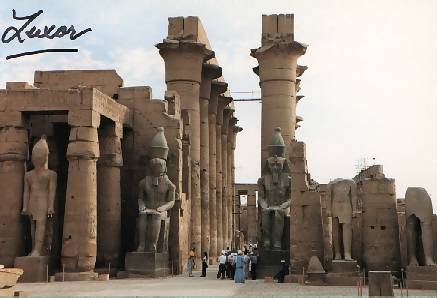
|
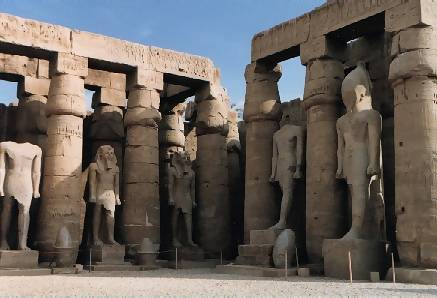
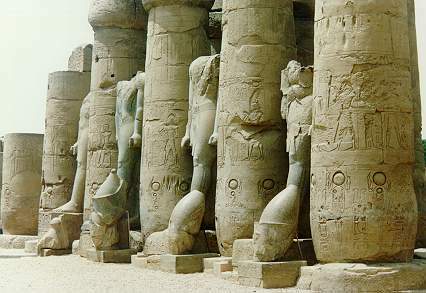
|
Luxor Temple: Open from 7a.m.-10p.m. in summer and 7a.m.-9p.m. in winter. Entrance fee LE 20 for tourists.
- Luxor Museum: Open from 9a.m-1p.m and 5p.m.-10p.m. Entrance fee LE 8 and and addition LE 10 for the new hall.
- This small museum displays chosen pieces excavated in the Luxor area dating from the prehistoric through to the Islamic eras.
West Bank:
- Valley of the Queens: Open from 7a.m.-6p.m.. Entrance fee LE 12 for tourists.
- The Valley of the Queens consists of over 70 tombs, many in ruins. The above fee will permit you access to three tombs: Amun-hir-khopshef, son of Ramses II with exquisite murals; Khaemwese, son of Ramses III, with a highly elaborate tomb; and Queen Titi, with interesting paintings of gods and demons. The tomb of Queen Nefertari, wife of Ramses II, will cost an addition LE 100.
QUEEN HATSHEPSUT'S TEMPLE
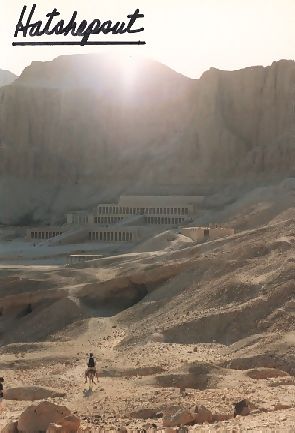
Queen Hatshepsut's monument at dawn (above).
A close-up view of the funerary complex (right).
|
Known as Deir El Bahari, the Mortuary Temple of Queen Hatshepsut is surrounded by sandstone cliffs. Queen Hatshepsut, the first woman to be Pharaoh, commissoned this beautiful temple, although it is said that she was never actually entombed here. |
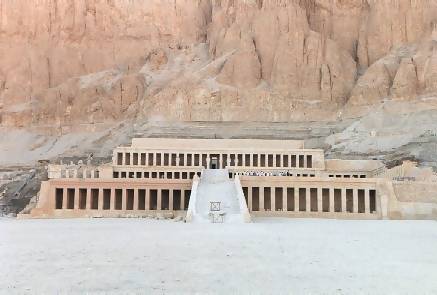 |
Queen Hatshepsut's funerary temple: Open from 7a.m.-6p.m.. Entrance fee LE 12 for tourists.
COLLOSSI OF MEMNON
 |
Named after the Trojan hero Memnon by the Greeks, the statues are actually of Amenopis III.
|
Colossi of Memnon: Open daily. No entrance fee.
VALLEY OF THE KINGS
|
The royal burial site for Pharaohs of the 19th-20th dynasties, now with Disney-like trams to move you around the site. The fee will permit you entry into three tombs (the selection may rotate). On my last visit I saw Ramses III (many side chambers), Ramses IV (ceiling painting of the goddess Nut), and Tuthmosis III (refreshingly modest). Tutankhamun's tomb (below) is an additional LE 40 (but note that although the king is still inside, all the treasures have been removed to the Egyptian Museum in Cairo). 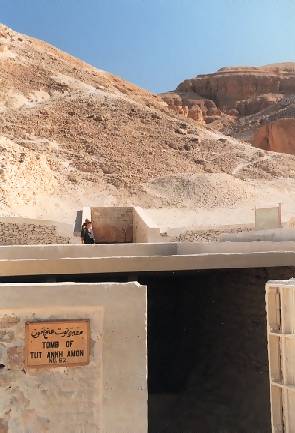
|
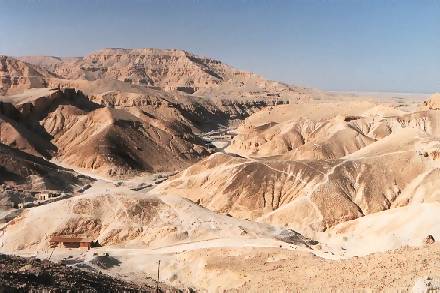
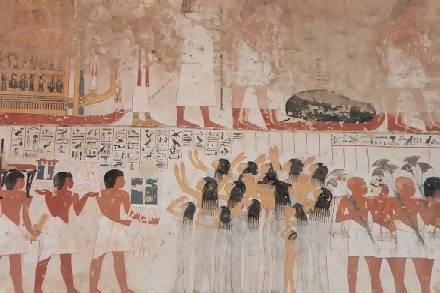
|
Valley of the Kings: Open 7a.m.-6p.m. Entrance fee LE 20 for tourists.
- Ramesseum: Open from 7a.m.-6p.m. Entrance fee LE 12 for tourists.
- This Mortuary Temple of Ramses II is remarkable for its gigantic statue of the Pharaoh.
- Valley of the Nobles: Open 7a.m.-6p.m. Entrance fee LE 12 for two tombs.
- These private tombs of priests and noblemen offer a fascinating glimpse at the social structure during the New Kingdom. Most tombs are in superb condition. Two working villages may be seen nearby.
South of Luxor:
- Esna: 55 km from Luxor. Open 7a.m.-6p.m. Entrance fee LE 8 for tourist.

The easiest way to visit Esna is by bus or service taxi. The temple is 50 meters inland beyond the tourist market, but you will have to find the ticket office first (near the mooring of the boats).
- The Temple of Khnum lies in the centre of this small town. Considered to be the last of the Ancient Egyptians monuments, this temple is most famous for its Hall of Columns.
EDFU
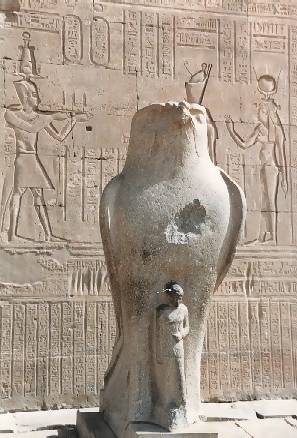
Black granite statues of Horus guard the temple (above).
The Temple of Edfu is the best preserved temple in the whole of Egypt (right).
|
An outstanding temple of Ptolemaic architecture dedicated to the god Horus. Of particular note is the temple walls detailing the battle between Horus and Seth. |
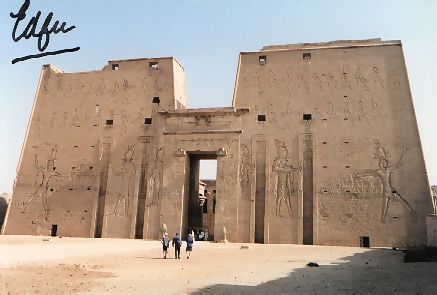 |
Edfu: 110 km from Luxor. Open 7a.m.-6p.m. Entrance fee LE 20 for tourists.
You can reach Edfu by bus from either Aswan (LE2.50) or Luxor (LE4). Service taxis cost about LE2 from Esna (1 hour), LE5 from Luxor and LE3.50 from Aswan (both 2 hours). You will have to locate another ride to reach the temple.
KOM OMBO
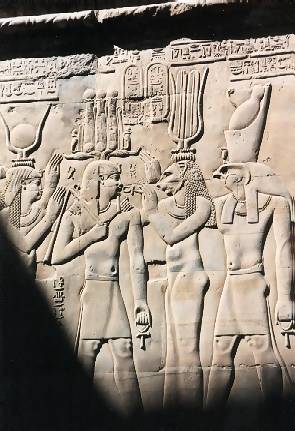
A detailed panel from the temples at Kom Ombo (above).
Kom Ombo as you approach it from the Nile (right).
|
This two-temples-in-one dedicated to the gods Sobek and Haroeris lies on the bank of the Nile. This temple was once a santuary for pregnant women. Today, be sure to see the mummified crocodiles and Nilometer. |
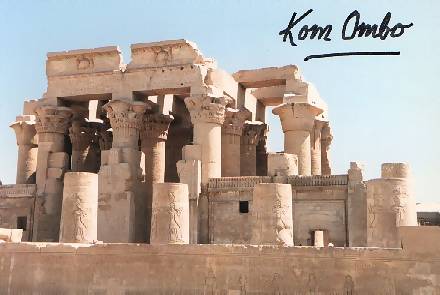 |
Kom Ombo: 170 km from Luxor. Open 7a.m.-6p.m. Entrance fee LE 10 for tourists.
To reach Kom Ombo, you can take a bus or a service taxi from Aswan for about LE2. From the drop-off point, take another ride to the Nile bank and walk to the temple. A taxi should cost about LE7 for the round-trip.

|
ASWAN
|
Aswan is very much a city of the Nile, with a pace that matches the many feluccas that sail gracefully by its banks. There is little in the way of monuments, apart for the exceptional Temple of Philae and the grand Temple of Ramses II in Abu Simbel. Aswan is more a place to visit at the start or completion of a leisurely cruise down the Nile to Luxor.
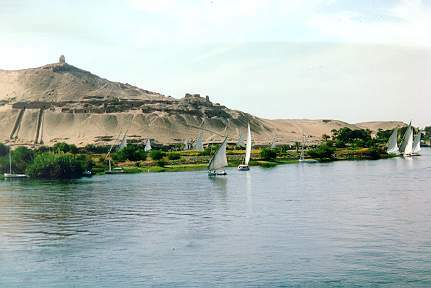
|
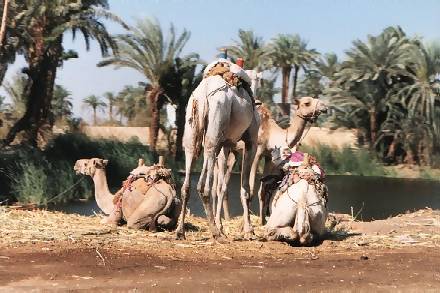
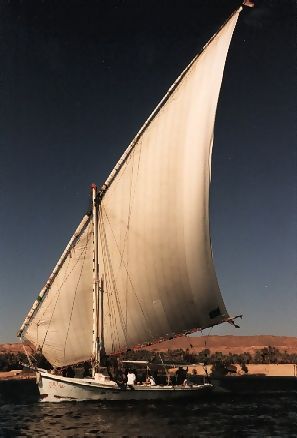
|
Hotel:
- *****Aswan Oberoi Hotel: Elephantine Island. Tel: 314-667
- ****Isis Hotel Aswan: Corniche El Nil. Tel: 315-100
- *****Isis Island: Ambonarti Island. Tel: 317-400
- ****Kalabsha Hotel: Abtal El Tahrir St. Tel: 322-666
- *****Sofitel Old Cataract Aswan Hotel: Abtal El Tahrir St. Tel: 316-000
Sightseeing:
- Elephantine Island: No entrance fee
- Home to the Nilometre (the gauge which the Ancient Egyptians used to ascertain the height of the Nile River at flood-time).
- Botanical Gardens: Kitcheners Island. Open 7a.m.-6p.m. Entrance fee LE 5 for tourists.
- A large collection of plants and flowers.
- Tomb of the Agha Khan: Open 7a.m.-6p.m. No entrance fee.
- The Aga Khans mausoleum was built on the western bank of the Nile.
- High Dam at Aswan: Open 7a.m.-6p.m. Entrance fee LE 2 for tourists.
- Completed in 1971, this is one of the three largest dams in the world.
- Nubian Museum: near the Basma Hotel. Open 9a.m.-1p.m. and 5p.m.-10p.m. Entrance fee LE 20 for tourists.
- Nubian collection of antiquities.
- Tombs of the Nobels: West Bank. Open 7a.m.-6p.m. Entrance fee LE 12 for tourists.
- Tombs of princes and nobles from the Old and Middle Kingdom.
PHILAE
| The Temple of Philae is one of the best preserved Ptolemaic temples in Egypt. The temple is dedicated to the goddess Isis, whose cult had a tradition that every Egyptian should visit the temple once in his life.
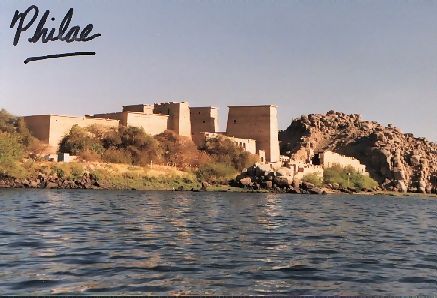
|
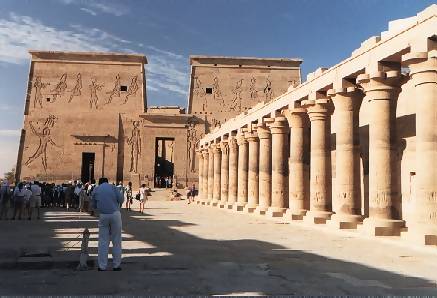
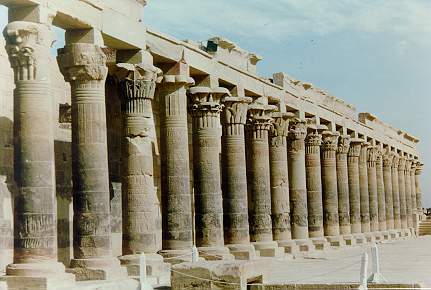
|
- Temples of Philae: Open 7a.m.-6p.m. Entrance fee LE 20 for tourists.

For Philae, you can only reach the boat landing at Shellal from Aswan by taxi for about LE20. At Shellal you take a small motorboat to the island (LE14) for the ride (not per person).
- Dating back to the Ptolemaic and Roman period, these temples were moved to the current location. Most impressive is the Temple of Isis.

|
ABU SIMBEL
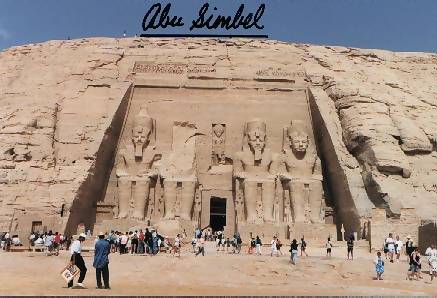
Nestled in a hillside along the Nile, The Great Temple of Ramses II is over 20 meters high (above).
Built in the 13th century B.C., Ramses commissioned four statues of himself which face the rising sun (right, top).
Nefertari, his favorite wife, has her own temple (right, bottom).
|
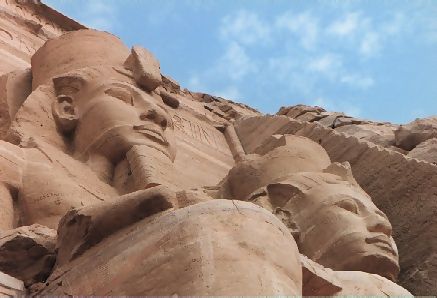 |
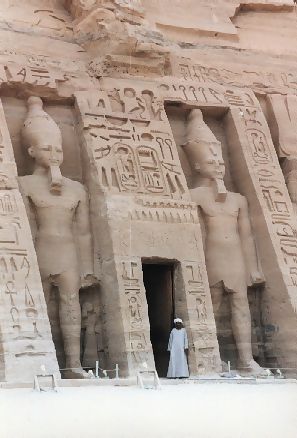 |
Sightseeing:
- Abu Simbel: 280 km from Aswan. Open 7a.m.-6p.m. Entrance fee for tourists LE 20 for Ramses II temple and LE 10 for Nefertari temple.

- Enormous temples commissioned by Ramses II for himself and his wife.
Hotel:
- ****Neferteri Hotel: Abu Simbel. Tel: 400-509

|



 Main Page
Main Page  Our Disclaimer Our Disclaimer  Practical Guide Practical Guide  Fun & Food Fun & Food  Hotels & Sightseeing Hotels & Sightseeing 
|
 Arabic Arabic  Women's Issues
Women's Issues  Ask Away
Ask Away  Anecdotes Anecdotes 
| |








![]()

![]()

![]()
![]() Main Page
Main Page ![]() Our Disclaimer
Our Disclaimer  Practical Guide
Practical Guide ![]() Fun & Food
Fun & Food ![]() Hotels & Sightseeing
Hotels & Sightseeing ![]()